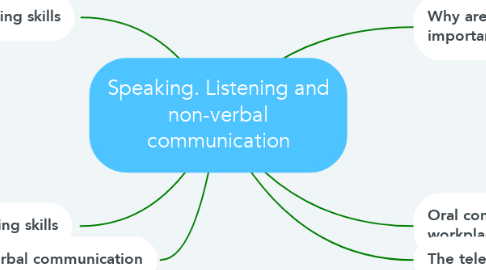
1. Speaking skills
1.1. Oral presentation
1.1.1. What is a presentation
1.1.2. Get to know your listeners
1.1.3. Analyse the circumstances around your talk
1.1.4. The location and the size of the audience
1.1.5. Brainstorm the topic
1.1.6. Get the hard information
1.1.7. Write the draft and read it loud
1.1.8. Beyond the rough Draft
1.1.9. Practice practice practice
1.1.10. Delivery of your speech
1.1.11. Handling Questions
2. Listening skills
2.1. Listening process
2.1.1. Receiving
2.1.2. Interpreting
2.1.3. Remembering
2.1.4. Evaluating
2.1.5. Responding
2.1.6. Acting
2.2. Barriers to effective listening
2.2.1. Pre-judgement
2.2.2. Selfishness
2.2.3. Selective listening
2.3. Techniques for effective listening
2.3.1. Prepare to listen
2.3.2. Avoid pre-judgement
2.3.3. Be open-minded
2.3.4. Establish eye contact
2.3.5. Don’t interrupt
2.3.6. Watch for signals
2.3.7. Judge content
2.3.8. Extract key points
2.3.9. Give feedback
2.3.10. Block out distractions
3. Non-verbal communication
3.1. Posture
3.2. Facial expressions
3.3. Gestures
3.4. Eye contact
3.5. Touching
3.6. How to improve your non-verbal communication skill
3.6.1. Be honest
3.6.2. Use a firm, friendly handshake
3.6.3. Maintain eye contact
3.6.4. Reinforce your word with tones and gestures
3.6.5. Be aware of your posture
3.6.6. Use appropriate gestures to support your points
4. Why are communication skills important
4.1. To secure an interview
4.2. To get the job
4.3. To do our job well
4.4. To advance in our career
5. Oral communication in the workplace
5.1. A private discussion
5.2. A conversation over lunch
5.3. A gossip in the lift
5.4. A telephone conversation
5.5. A chance meeting in the corridor
5.6. An informal gathering of staff
5.7. Instructing subordinates
5.8. Dealing with clients
5.9. Formal meeting
5.10. Interviews
5.11. Training sessions
5.12. Giving a presentation
5.13. Conferences/seminars
6. The telephone
6.1. Making effective telephone calls
6.1.1. Before calling
6.1.1.1. Choose the right time to call
6.1.1.2. Check the number
6.1.1.3. Plan your call
6.1.1.4. Be prepared
6.1.1.5. Avoid interruptions
6.1.2. During the call
6.1.2.1. Be courteous and establish a rapport
6.1.2.2. Put a smile in your voice
6.1.2.3. Check your note
6.1.2.4. Obtain feedback
6.1.2.5. Close in a positive, courteous manner
6.1.3. After the call
6.1.3.1. Make note
6.2. Taking the messages
6.3. Voice processing
6.3.1. Recording your voice mail greeting
6.3.2. Leaving a voice mail message

